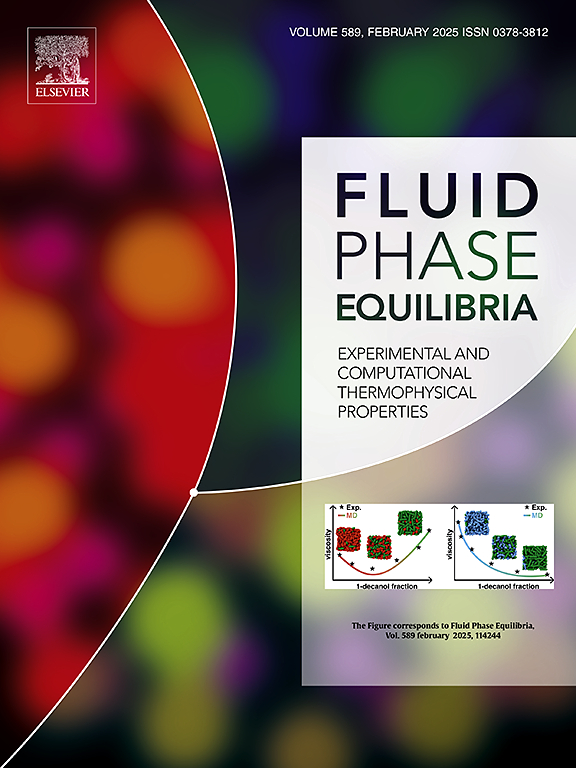Modeling of interfacial phenomena in disperse liquid-liquid systems
IF 2.7
3区 工程技术
Q3 CHEMISTRY, PHYSICAL
引用次数: 0
Abstract
Interfaces are critical in chemical engineering, as they govern mass transfer between phases and play a key role in the formation and behavior of droplets and bubbles. This is particularly true in liquid-liquid extraction columns, where droplet interactions such as coalescence and breakage are pivotal. In decades of research, droplet coalescence remains a complex phenomenon that is not yet fully understood, partly due to the challenges in experimentally analyzing the small-scale and fluid nature of interfaces. To address this gap, we propose a thermodynamically consistent simulation approach to accurately resolve interfaces and study droplet interactions. The developed model builds on the incompressible Density Gradient Theory (DGT) by Cahn and Hilliard, coupling it with the Navier-Stokes equations to form a novel Navier-Stokes/DGT framework. Within this framework, the Non-Random Two-Liquid model is employed as the thermodynamic foundation, enabling the accurate modeling of interfacial properties and prediction of coalescence behavior in liquid-liquid systems. The Navier-Stokes/DGT model, comprising a system of highly nonlinear partial differential equations is solved using the finite volume method in OpenFOAM. This approach enables the simulation of the single stages of droplet coalescence. Furthermore, complex interfacial effects like Marangoni convection and de-mixing behavior are investigated in more detail.
分散液-液系统界面现象的建模
界面在化学工程中是至关重要的,因为它们控制着相之间的传质,在液滴和气泡的形成和行为中起着关键作用。在液-液萃取柱中尤其如此,其中液滴的相互作用,如聚结和破裂是关键。在几十年的研究中,液滴聚结仍然是一个尚未完全理解的复杂现象,部分原因是在实验分析界面的小规模和流体性质方面存在挑战。为了解决这一差距,我们提出了一种热力学一致的模拟方法来准确地解析界面和研究液滴相互作用。该模型建立在Cahn和Hilliard的不可压缩密度梯度理论(DGT)的基础上,将其与Navier-Stokes方程结合起来,形成了一个新的Navier-Stokes/DGT框架。在此框架下,采用非随机双液模型作为热力学基础,实现了对液-液体系界面性质的精确建模和聚结行为的预测。采用有限体积法求解了由高度非线性偏微分方程组组成的Navier-Stokes/DGT模型。这种方法可以模拟液滴聚结的单个阶段。此外,对Marangoni对流和脱混行为等复杂界面效应进行了更详细的研究。
本文章由计算机程序翻译,如有差异,请以英文原文为准。
求助全文
约1分钟内获得全文
求助全文
来源期刊

Fluid Phase Equilibria
工程技术-工程:化工
CiteScore
5.30
自引率
15.40%
发文量
223
审稿时长
53 days
期刊介绍:
Fluid Phase Equilibria publishes high-quality papers dealing with experimental, theoretical, and applied research related to equilibrium and transport properties of fluids, solids, and interfaces. Subjects of interest include physical/phase and chemical equilibria; equilibrium and nonequilibrium thermophysical properties; fundamental thermodynamic relations; and stability. The systems central to the journal include pure substances and mixtures of organic and inorganic materials, including polymers, biochemicals, and surfactants with sufficient characterization of composition and purity for the results to be reproduced. Alloys are of interest only when thermodynamic studies are included, purely material studies will not be considered. In all cases, authors are expected to provide physical or chemical interpretations of the results.
Experimental research can include measurements under all conditions of temperature, pressure, and composition, including critical and supercritical. Measurements are to be associated with systems and conditions of fundamental or applied interest, and may not be only a collection of routine data, such as physical property or solubility measurements at limited pressures and temperatures close to ambient, or surfactant studies focussed strictly on micellisation or micelle structure. Papers reporting common data must be accompanied by new physical insights and/or contemporary or new theory or techniques.
 求助内容:
求助内容: 应助结果提醒方式:
应助结果提醒方式:


